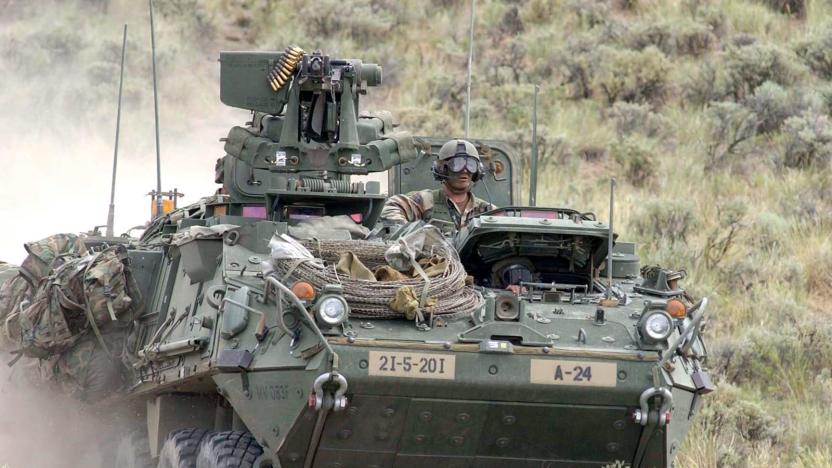LaserWeapon
Latest

The army may have laser-equipped vehicles by 2017
The army, in partnership with General Dynamics, is developing a short-range laser weapon designed to protect soldiers against mortars, missiles and drones. The news was broken by Scout Warrior, which reports that the weapon could be implemented in as little as a year. The idea is that the technology would be installed on the roof of an armored personnel vehicle -- specifically a General Dynamics Stryker (pictured). Once operational, the technology will scan the immediate area and destroy anything suspicious that approaches by air.

Rheinmetall 50kW laser weapon aces latest test, pew-pews a 3-inch ballistic target
In the "sure wish we had a video" category, aptly-monikered defense contractor Rheinmetall has run a highly successful test of its 50kW high-energy laser weapon. It works by hunting down incoming targets using a so-called Skyguard radar system, then locking in with an optical scanner before firing multiple, superimposed beams for extra energy. During the Swiss trials, the German-made HEL cannon managed to cut through a 15mm steel girder from over 3,200 feet away and knock down several drones diving at over 110 mph. Most impressively, the laser succeeded in dipatching an 82mm steel projectile in flight, showing the viability of beam-based weapons against potential mortar attacks. Rheinmetall has quintupled the power in just the last year, and plans to ramp up the juice to 60kW in 2013 trials, saying "nothing stands in the way" of a future 100kW system. Of course if that doesn't work out, it could always start up a death metal band.

Senate denies Navy's missile-destroying laser funding, puts the kibosh on annoying Dr. Evil impressions
Leave it to the Senate to crush the military's fragile dreams. All the Navy ever really wanted was a giant ship-based laser that could be used to shoot down missiles. Despite some record breaking stats, however, the latest defense authorization bill handed down from the Senate Armed Services Committee throws a giant congressional wet blanket on the free-electron laser. The project, it seems, has simply proven too expensive -- among other things, the laser's researchers haven't found the ideal method for powering the weapon from a ship. According to the current timeline, the project was not likely to have been completed before 2020, and as such the Navy's request for further funding was, somewhat ironically, ultimately shot down.

US Navy's free-electron laser breaks another record, takes aim at missiles next
The US Navy's free-electron laser has broken a few records already, but it's just plowed through another fairly big one -- one that its creators say could put it on the fast track to actually being used to shoot down missiles. That particular record involved running the system for eight hours at 500 kilovolts, which is a level they've been trying to achieve for the past six years and, according to the researchers, "definitely shortens" the time frame for getting to their ultimate goal of 100 kilowatts. What's more, while this particular test didn't actually involve blowing anything up, the Navy seems confident that the laser will eventually be able to do just that, as it's just recently awarded Boeing a $163 million contract to package the laser in a weapons system that would be deployed on ships and be able to detect, track, and destroy missiles (or presumably anything else ). According the Office of Naval Research, the Navy hopes to meet that goal by 2015. [Image: Wired / Danger Room]

Northrop Grumman's weaponized laser on sale now, definitely won't hug you
The last time we heard anything about Northrop Grumman's development of a weaponized laser system, they were telling us that the "hardest part was over," and it looks like they weren't exaggerating. According to today's PR released by the 4th largest defense contractor in the world, the units, dubbed FIRESTRIKE, are now "ready for sale." In case you haven't been following every detail of the story, the FIRESTRIKE is a solid-state laser (think raygun), which weighs 400 pounds, has an Ethernet interface, and can be chained together with up to 7 other identical modules to create a 100 kw beam. The unit's obviously not very portable, and we don't have any information on its price, but we're going to go ahead and assume we can't afford it. Enemies of Engadget: you're safe, at least for now.

Northrop Grumman's laser system passes second major milestone
Last we heard from Northrop Grumman it was making some steady progress towards a weapons-grade laser system, and it now looks like that's even closer to becoming a reality, with the company announcing that the system has passed its second major milestone with flying colors. According to the company, the key "laser chain" component was demonstrated on December 20th, 2007, and actually exceeded all target requirements, including reaching a power of 15.3kW, a good deal above the 12.7kW they were aiming for. That component is just one part of the so-called Joint High-Powered Solid State Laser Phase 3 Program, which is designed to combine eight laser chains for a peak power level of 100kW, otherwise known as the level deemed necessary for weapons-grade laser systems. While there's still no indication as to when that might happen, Northrop Grumman has gone as far to say that, with this latest test, "the hardest part is over," so it looks like it might not be as far off as you might think.[Via The Register]



